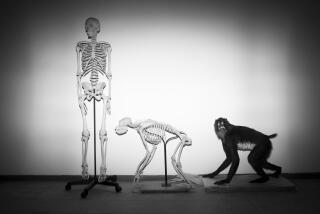With four flippers, how did the plesiosaur swim? Like a penguin, study says
Among the stranger creatures to roam the earth during the time of the dinosaurs was not a dinosaur at all, but a marine reptile — the plesiosaur. This odd predator navigated Mesozoic Era waters with four flippers — two in the front and two in the back — a design unlike anything seen in modern-day swimmers. How the plesiosaur actually used its limbs to swim has remained something of a mystery.
But in a study in the journal PLOS Computational Biology, a group of scientists has used computer modeling to pin down what those strokes might have looked like — and it turns out that they probably looked a lot like a penguin’s.
Plesiosaurs were a diverse group of swimming reptiles that thrived for 135 million years, from the Early Jurassic to the Late Cretaceous period (when they were wiped out by the same asteroid that took out the dinosaurs). Some had long necks, others had short stubby ones, but all of them had this four-flippered body plan, where the animals’ legs had evolved into two pairs of wing-like appendages — “a unique adaptation in the animal Kingdom,” the study authors wrote.
“Although plesiosaurs were a key component of Mesozoic marine ecosystems, there are no extant ‘four-winged’ analogues to provide insights into their behavior or ecology, and their locomotion has remained a topic of debate since the first complete plesiosaur skeleton was described in 1824,” the authors wrote.
Join the conversation on Facebook >>
Without any clear modern comparisons, how theirs flippers worked together has stumped scientists.
Some have argued that the plesiosaur had a rowing stroke, using its fins like boat oars; others argued for a “flight stroke,” rather like those of penguins and turtles, or a modified flight stroke like the ones sea lions use.
The extinct animals’ swimming motion has been equally up for grabs: Some have posited synchronous motion, with all four flippers moving in the same direction at the same time; others have favored semi-synchronous or asynchronous motion, where the forelimbs and hindlimbs move out-of-phase relative to each other. Researchers haven’t even been able to agree on whether it was the forelimbs or the hindlimbs producing most of the animal’s thrust.
Scientists have tried all kinds of ways to model the animals’ swimming behavior, from using experimental robots to testing out human swimmers using paddles.
“These studies, although informative, are limited because they do not deal with accurate representations of the plesiosaur form,” the study authors wrote. “There is therefore still no consensus on how plesiosaurs swam, especially how they moved all four limbs relative to each other.”
NEWSLETTER: Get the day’s top headlines from Times Editor Davan Maharaj >>
To get a better handle on plesiosaur physiology, researchers from Georgia Tech decided to build a computer model — far more accurate than, say, a human with some paddles. They based theirs on Meyerasaurus victor, a Lower Jurassic plesiosaur from what is now Germany that would have stretched about 11 feet (relatively small by plesiosaur standards). This model also allowed researchers to test thousands of simulations to try to determine which combinations of movement allowed the animal to move most effectively through the water.
In the end, the scientists found that the plesiosaur was swimming mostly with its forelimbs; surprisingly, the hindlimbs didn’t generate much thrust and likely were used for balance and steering.
“Within the biologically possible range of limb motion, the simulated plesiosaur swims primarily with its forelimbs using an unmodified underwater flight stroke, essentially the same as turtles and penguins,” the study authors wrote.
Now that the scientists have developed a working model of this plesiosaur, they can use it to further probe exactly how the hindlimbs were used — and to explore the motion of other extinct swimming animals.
Love science? Follow @aminawrite on Twitter for dispatches from the Lost World.
MORE FROM SCIENCE
Cancer: More than just bad luck?
Could neutralizing some gut microbes prevent heart disease?
Climate change: Greenland Ice Sheet is shrinking at high rate







